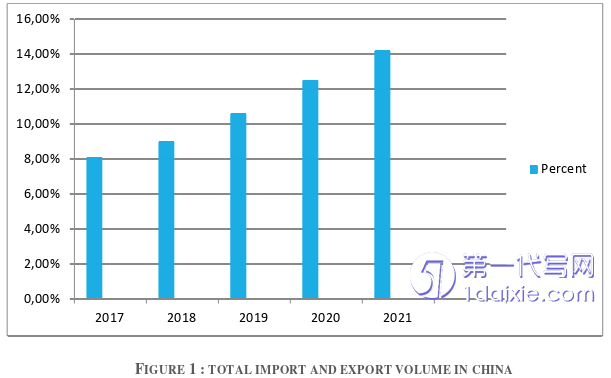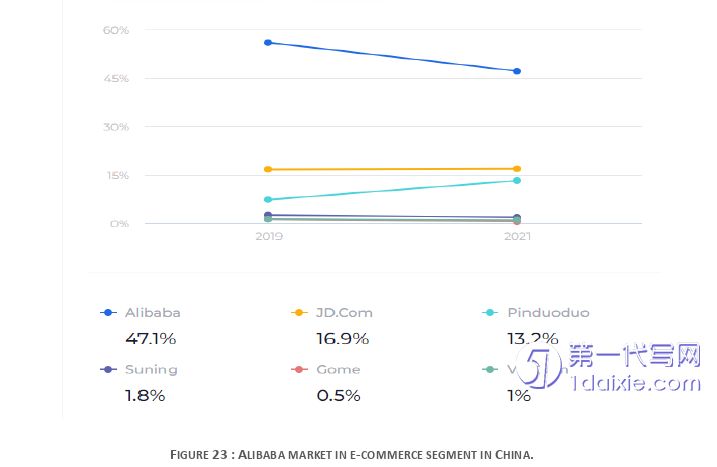本文是一篇电子商务论文,笔者认为电子商务已经成为企业扩大业务范围和开拓新市场的一种流行方式。高速互联网、智能手机和在线平台的可用性使公司更容易接触到新市场的客户,也使消费者更容易在世界任何地方在线购物。
Chapter 1 Introduction
1.1 Research Background and significance
1.1.1 Research background

In the past few decades, the world has seen a tremendous shift in the way business is conducted. The widespread use of technology and the internet has given birth to e-commerce, which enables businesses to reach customers across borders and without the limitations of traditional stores. China in particular has seen a rise in cross-border e-commerce, and its ever-growing population is an attractive market for foreign companies. Cross-border e-commerce has become an important part of the global economy in recent years, fueled by advances in technology and logistics infrastructure. With the advent of e-commerce platforms like Alibaba, Amazon and eBay, consumers can now easily buy products from retailers around the world and businesses can expand beyond their home country. This has led to the development of cross-border trade and the emergence of new business models that use the internet to reach customers in new markets. China is at the forefront of the cross-border e-commerce trend with a fast-growing market and growing influence in global trade. According to a report by e-Marketer, cross-border e-commerce sales in China are expected to reach US$203.2 billion in 2021, making China the largest cross-border e-commerce market in the world. The Chinese government has recognized the potential of cross-border e-commerce to boost economic growth and has taken measures to support its development. However, cross-border e-commerce also poses challenges for businesses and governments, including issues related to customs clearance, taxes and intellectual property rights. There are also concerns about the impact of cross-border e-commerce on traditional retail and distribution channels and the possibility of counterfeit and substandard products entering the market. Given the importance of cross-border e-commerce to the global economy and China's role as a major player in this market, it is important to understand the trends and impact of cross-border e-commerce in China.
1.2 Literature Review
1.2.1 The cross-border e-commerce in china
At present, cross-border e-commerce is very different from international e-commerce, which is described, for example, in Bradley et al. (1999) and Fuah and Tucci (2001), In China, due to appropriate policy support and the gradual establishment of e-commerce platforms, the cross-border e-commerce industry has experienced stable and rapid development, while the integrated industry chain of marketing, payment transactions, logistics and financial services took shape. While the compound annual growth rate of traditional Chinese foreign trade fell to less than 10 tweens 2012 and 2016 (NBS, 2017), the corresponding rate of cross-border e-commerce remained between 20% and 50%. The total transaction volume of China's e-commerce imports and exports in 2013 reached 3.15 trillion Yuan, according to CECRC (2017), while the growth rate was 50%. This accounted for 12.2% of China's total import and export volume in the same year. In 2016, the volume of cross-border e-commerce transactions in China reached RMB 6.7 trillion, with a CAGR of more than 20%, accounting for about 28% of China's imports and exports over the same period. The trading volume was estimated at 8 RMB.8 trillion by 2018 (iiMedia Research, 2017) and up to 12 trillion RMB by 2020, accounting for about 37.6% of China's total import and export volume, the market extends to over 1 billion customers (AliResearch, 2016). In addition, from a global perspective, the report data shows that China's cross-border B2C e-commerce sales amounted to US$766.5 billion in 2015 (Ecommerce Foundation, 2016).
Chapter 2 Current status and trends of cross-border e-commerce
2.1 The trends and development of cross-border e-commerce
When the Internet first started serving as a trading platform in the 1990s, the idea of cross-border e-commerce initially emerged. In the early days of e-commerce, cross-border transactions were limited by the lack of international payment systems and language barriers. However, with the development of digital payment systems and the expansion of the Internet, cross-border e-commerce has become a global phenomenon, with businesses and consumers participating in international transactions on a daily basis.
The early stages of cross-border e-commerce were marked by the emergence of online marketplaces, such as eBay and Amazon, which allowed sellers to reach customers in different countries. These markets provided a platform for small businesses to access global markets and expand their customer base. However, the growth of cross-border e-commerce has been hampered by logistical challenges, such as shipping and delivery, which has made it difficult for companies to deliver products to customers in a timely and cost-effective manner.
In recent years, the development of cross-border e-commerce has been driven by technological advances and the emergence of new business models. For instance, corporations are now able to contact new customers and advertise their products more effectively because to the growth of mobile technology and social media platforms. The emergence of cross-border payment systems, such as PayPal and Alipay, has made it easier to deal with customers in different countries. Moreover, the growth of cross-border logistics networks, such as express delivery services, has enabled companies to deliver products to customers in a timely and cost-effective manner.
2.2 The trends and market size of Cross-border e-commerce
Recent years have seen a considerable increase in cross-border e-commerce, which has been fueled by technical advancements, shifting consumer trends, and trade globalization. Global cross-border e-commerce sales are anticipated to increase from $3.9 trillion in 2020 to $6.5 trillion by 2023, according to a forecast by eMarketer.
With more than 50% of all cross-border e-commerce sales occurring in this region, it is the largest cross-border e-commerce market. With more than 200 million online customers in 2020, China will have the largest cross-border e-commerce market in the world, followed by the United States and the United Kingdom.
The expansion of mobile commerce is one of the key trends in international e-commerce. Cross-border e-commerce has been significantly impacted by the shift from desktop computers to mobile devices as the primary method of accessing the Internet. Consumers now find it simpler to shop online thanks to mobile commerce, which has also made it possible for companies to advertise to new clients on their mobile devices.
Chapter 3 The impact of cross-border e-commerce.................................19
3.1 The economy impact..............................19
3.1.1 Increased international trade..................................19
3.1.2 Boost to the Chinese economy.....................20
Chapter 4 Methodology........................28
4.1 Research Design........................................28
4.2 Data Collection.......................................28
4.3 Data Analysis................................28
Chapter 5 The role of the government in cross-border e-commerce........45
5.1 The Chinese government...........45
5.1.1 Policy support........................45
5.1.2 Infrastructure development............................48
Chapter 7 The benefits and challenges of cross-border e-commerce in china
7.1 The benefits of cross-border e-commerce in china
7.1.1 Reduced overhead costs
Reduced overhead costs are another significant benefit of cross-border e-commerce in China. Traditional retail businesses in China require significant investment in physical stores, staff, inventory management, and marketing, which can lead to high overhead costs. Cross-border e-commerce, on the other hand, can offer businesses a more cost-effective way to sell their products in China.
With cross-border e-commerce, businesses can operate without the need for physical storefronts or the associated costs of rent, utilities, and staffing. This can significantly reduce overhead costs and make it easier for businesses to achieve profitability in the Chinese market.
cross-border e-commerce can also offer businesses greater flexibility in terms of inventory management. With traditional retail businesses, businesses need to purchase and store inventory in anticipation of consumer demand. With cross-border e-commerce, businesses can utilize a more just-in-time inventory model, only ordering products when they receive customer orders. This can help to reduce inventory carrying costs and minimize waste.the reduced overhead costs associated with cross-border e-commerce can help businesses to operate more efficiently and achieve profitability in the Chinese market.

Chapter 8 Conclusion and Recommendations
8.1 Conclusion
In conclusion, globalization and the growth of e-commerce have revolutionized the way businesses operate and trade cross-borders. E-commerce has become a popular way for businesses to expand their reach and tap into new markets. The availability of high-speed internet, smartphones, and online platforms has made it easier for companies to reach customers in new markets, and for consumers to shop online from anywhere in the world. However, the growth of e-commerce has also raised concerns about the impact on traditional retail and distribution channels, taxation, intellectual property rights, and consumer protection. While globalization and e-commerce offer many advantages, it is important to address these challenges and ensure that businesses and consumers can take advantage of the opportunities they offer.
Cross-border e-commerce has become a global phenomenon, driven by technological advances and the emergence of new business models. The growth of cross-border e-commerce has been hampered by logistical challenges, such as shipping and delivery, but the development of cross-border logistics networks and payment systems has enabled companies to overcome these challenges. The trend towards service competition and one-stop service approach in cross-border e-commerce is driven by the desire to differentiate and stand out in an increasingly crowded marketplace, and to provide customers with a seamless end-to-end e-commerce experience. The evolution and development of cross-border e-commerce in China is particularly significant, as it has become one of the largest cross-border e-commerce markets in the world, with significant implications for businesses, consumers, and policymakers. As cross-border e-commerce continues to grow, it is important for businesses and policymakers to stay informed of the latest trends and developments, in order to effectively navigate this rapidly changing landscape.
reference(omitted)
